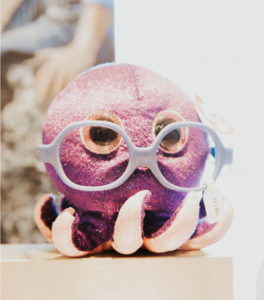PEDIATRIC EYE CARE
 Childhood eye exams are important to ensure your child’s vision health, and promote success in the classroom. And early detection is the key to successful prevention or treatment of serious vision conditions your child may have. If your child is struggling to read or complete schoolwork, you can feel confident that our eye doctors will provide your family with thoughtful, professional care and effective, affordable solutions for all of your child’s vision care needs. The Eye Associates proudly offers a large variety of name-brand eyeglasses just for kids. Feel free to stop by and browse our wide selection of metal and plastic frames in fun, bright colors your child will love!
Childhood eye exams are important to ensure your child’s vision health, and promote success in the classroom. And early detection is the key to successful prevention or treatment of serious vision conditions your child may have. If your child is struggling to read or complete schoolwork, you can feel confident that our eye doctors will provide your family with thoughtful, professional care and effective, affordable solutions for all of your child’s vision care needs. The Eye Associates proudly offers a large variety of name-brand eyeglasses just for kids. Feel free to stop by and browse our wide selection of metal and plastic frames in fun, bright colors your child will love!
DRY EYE TREATMENT
Dry eye is a complicated problem. Factors affecting tear production and the ocular surface result in symptoms of tearing, stinging and poor vision. When severe, dry eye can cause damage to the ocular surface, resulting in increased osmolarity of the tear film and inflammation of the ocular surface. Dry eye is one of the most under-diagnosed ocular diseases, and yet it is the most common reason why patients visit their eye care professional.
Dry eyes are common in our climate; and treatment is done in a step-wise fashion. We start with simple modifications to your daily routine.
 Avoid exposure to wind and the elements, as well as forced air (i.e. ceiling fans, air vents). Sometimes these situations are unavoidable, but doing the best you can to protect your eyes will greatly reduce your symptoms. There are even special sunglasses made to block exposure, which are available in our optical department.
Avoid exposure to wind and the elements, as well as forced air (i.e. ceiling fans, air vents). Sometimes these situations are unavoidable, but doing the best you can to protect your eyes will greatly reduce your symptoms. There are even special sunglasses made to block exposure, which are available in our optical department.- Remember to blink. When we read, work on the computer, or watch television, we tend to stare and blink less frequently. Try to be conscious of this and pause every five minutes to blink.
- Lubricate your eyes regularly. Use artificial tears at least 4 times a day (more if you’re noticing symptoms or are experiencing increased exposure to air movement). Brands we recommend are Systane, Refresh, Blink, Genteal, Freshkote, and TheraTears.
- Supplement with Omega 3’s orally. You need 1000mg from a fish-derived source (fish, krill or salmon oil) and 1000mg from a vegetable-derived source (flax seed, evening primrose or borage oil). We suggest you alternate your use of these, taking one in the morning and the other in the evening for maximum benefit. High quality fish oils are very important for proper absorption. Some recommended brands are PRN (sold here), Nordic Naturals or Core Omega.
- In cold weather, use a humidifier in your home.
If the treatment outlined above fails to improve your symptoms sufficiently, more advanced treatments may be called for:
- Restasis and Xiidra prescription eye drops to help you create more of your own natural tears.
- MiBo ThermaFlo, which provides a gentle heat treatment to unclog the oil glands along the margins of your eyelids and restore a healthy tear film.
- Tear-saver plugs, which help retain moisture in your eyes by plugging some or all of your tear drains.
- Punctal cautery if other treatments are ineffective.
Optical: Eyeglasses and Contact Lenses
Eyeglasses improve your vision by adjusting the way the eyes bend and focus light. Ideally, light rays are refracted (bent) as they pass through the cornea so that they focus on the retina in the back of the eye. In a healthy eye, this means that objects can be seen clearly. However, many people’s corneas have an irregular curvature which causes light rays to focus in front or behind the retina. Resulting in objects then appearing blurry at certain distances or at all distances.
Eyeglasses correct these refractive errors. Prescriptions are measured for each eye so patients can enjoy optimal vision clarity, usually 20/20. Eyewear may be used for certain activities, such as reading for farsighted (hyperopic) patients and driving or watching television for nearsighted (myopic) patients, or may be worn at all times.
 Who is a good candidate for eyeglasses?
Who is a good candidate for eyeglasses?
Anyone and everyone is a candidate for eyeglasses. Anywhere from a cosmetic look to prescription sunglasses.
How much do eyeglasses cost?
Eyewear is also based on the persons individual needs so pricing will vary. See our opticians for the perfect set of glasses for you.
We are happy to discuss the process of selecting glasses frames, upkeep, etc. Once you have your eyeglass prescription from your doctor, come visit us in our optical shop. You will find our experienced staff are ready to make your visit fun and easy. We have the knowledge to help select the perfect frame for your needs and also compliment your features. When you are ready to pick up your new glasses, our opticians will explain how to care for them.

 Childhood eye exams are important to ensure your child’s vision health, and promote success in the classroom. And early detection is the key to successful prevention or treatment of serious vision conditions your child may have. If your child is struggling to read or complete schoolwork, you can feel confident that our eye doctors will provide your family with thoughtful, professional care and effective, affordable solutions for all of your child’s vision care needs. The Eye Associates proudly offers a large variety of name-brand eyeglasses just for kids. Feel free to stop by and browse our wide selection of metal and plastic frames in fun, bright colors your child will love!
Childhood eye exams are important to ensure your child’s vision health, and promote success in the classroom. And early detection is the key to successful prevention or treatment of serious vision conditions your child may have. If your child is struggling to read or complete schoolwork, you can feel confident that our eye doctors will provide your family with thoughtful, professional care and effective, affordable solutions for all of your child’s vision care needs. The Eye Associates proudly offers a large variety of name-brand eyeglasses just for kids. Feel free to stop by and browse our wide selection of metal and plastic frames in fun, bright colors your child will love! Avoid exposure to wind and the elements, as well as forced air (i.e. ceiling fans, air vents). Sometimes these situations are unavoidable, but doing the best you can to protect your eyes will greatly reduce your symptoms. There are even special sunglasses made to block exposure, which are available in our optical department.
Avoid exposure to wind and the elements, as well as forced air (i.e. ceiling fans, air vents). Sometimes these situations are unavoidable, but doing the best you can to protect your eyes will greatly reduce your symptoms. There are even special sunglasses made to block exposure, which are available in our optical department. Who is a good candidate for eyeglasses?
Who is a good candidate for eyeglasses?